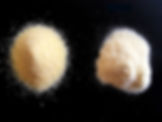Yellow flour, yellow bread
- Akis
- Nov 5, 2019
- 3 min read
Updated: Oct 20, 2021
Most people relate yellow flour with corn or potato, but this is not always the case
In Greece and other south European countries, the typical bread is white, meaning that it’s made from white flour. The latter is obtained after milling the grains of soft/bread wheat (Triticum aestivum) and sieving the resulted whole grain flour. Soft/bread wheat is the most cultivated wheat species worldwide. Second by far comes hard wheat (Triticum durum), also known as durum (the Latin word for hard). The name denotes that durum is the hardest from all wheats, a property that refers to the resistance of the grain to milling. Durum berries, compared to bread wheat, are also bigger and more amber-coloured. Durum likes the sun and thus it’s well adapted to hot and dry climates, like the areas around the Mediterranean sea.

Because of its resistance to milling, durum is appropriate for the production of semola or semolina, an endosperm-rich flour product, containing coarse-grained particles. Semola has a yellow/golden colour that reflects the high content of β-carotene in durum endosperm. Subsequent milling of semola produces a finer-grained flour, which is simply referred to as durum wheat flour.

Semola is mainly used for pasta production. It’s responsible for all goods of Italian pasta, like the ability to remain al dente after cooking and the rough texture that holds efficiently the sauce. On top of all, semola makes doughs that are plastic enough to be shaped to pasta forms that look like small sculptures and can keep their artistic shape after being thrown in boiling water.

Except for pasta, semola and generally durum wheat is used to make some of the most typical products in the Mediterranean and the Middle East, like couscous or bulgur. Additionally, many people are familiar with the sweet, semolina puddings that can be found widely.
In countries that it’s abundant, durum flour is used also for bread. In the south Italian region of Puglia, in the city of Altamura (also known as the city of bread), is produced one of the greatest Italian breads. Pane-di-Altamura is an artisanal product with a Protected-designation-of-Origin (PDO) mark, which is made from 100% local durum wheat flour, combined with sourdough fermentation and baked in wood-fired ovens. The same region is known for its focaccia that is made traditionally also with the same flour. Focaccia Barese is usually topped with cherry tomatoes and olives.

Greece produces also good quality durum. Particularly known are the ancient durum crops on the island of Limnos, or the ones in the Thessaly region. I have used already durum flour from Limnos and it worked perfectly for both pasta and bread.

Most Greeks though are familiar only with semola, which they use to make puddings and generally sweet preparations. However, you can still get in many bakeries a bread made from durum flour. It’s not named as such, but it’s usually called country or yellow bread. I find it particularly flavourful and I like to make it at home whenever I can get some Greek or Italian durum flour.

Durum flour sourdough bread
500g durum wheat flour
100g active sourdough
400g water
10g salt
( I have noticed that durum flour absorbs more water than soft wheat flour, hence the hydration level for the dough above is higher compared to a basic soft wheat dough. However, hydration levels are depended on many factors (flour origin and quality, environmental conditions etc.) and whatever numbers are stated here should considered only as guidelines)
- Mix well in a bowl all the ingredients until flour is fully hydrated. Cover and let it rest for 30 min.
- Stretch and fold the dough a few times and let it rest again for another 30 min.
(Due to its characteristics conventional kneading is not working good for developing the gluten of a durum wheat flour dough. I have noticed that a few stretch-and-fold rounds separated from resting periods are much better for good gluten formation)
- Perform a couple of more a stretch-and-fold rounds separated by 30 min. Use the windowpane test to assess gluten development.
- Let the dough to rest and ferment at room temperature for additional 2-3 hours, or until it is risen ca. 30-40% its original size. Then, transfer it in the fridge for up to a day.
- When ready to bake, preheat the oven at min. 220 °C, take out the dough from the fridge, shape it briefly onto a well-floured surface, and bake it directly for an hour.

